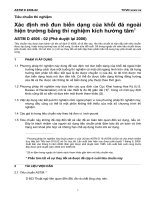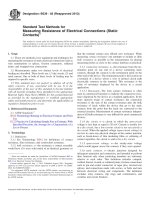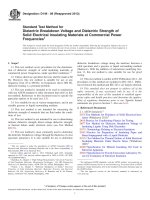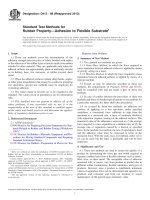Astm d 801 02 (2013)
Bạn đang xem bản rút gọn của tài liệu. Xem và tải ngay bản đầy đủ của tài liệu tại đây (70.93 KB, 2 trang )
Designation: D801 − 02 (Reapproved 2013)
Standard Test Methods for
Sampling and Testing Dipentene1
This standard is issued under the fixed designation D801; the number immediately following the designation indicates the year of
original adoption or, in the case of revision, the year of last revision. A number in parentheses indicates the year of last reapproval. A
superscript epsilon (´) indicates an editorial change since the last revision or reapproval.
D6166 Test Method for Color of Pine Chemicals and Related Products (Instrumental Determination of Gardner
Color)
D6387 Test Methods for Composition of Turpentine and
Related Terpene Products by Capillary Gas Chromatography
E300 Practice for Sampling Industrial Chemicals
1. Scope
1.1 These test methods cover procedures for sampling and
testing dipentene and related terpene solvents, consisting
chiefly of monocyclic terpene hydrocarbons distilling above
the range for turpentine.
1.2 The procedures given in these test methods appear in the
following order:
Sampling
Detection and Removal of Separated Water
Appearance
Color
Odor
Specific Gravity
Refractive Index
Composition
Flash Point
Moisture
3. Significance and Use
Section
4
5
6
7
8
9
10
11
12
13
3.1 The testing procedures described in these test methods
have been in use for many years and emphasize the physical
properties rather than the chemical composition of dipentene.
These procedures were sufficient when dipentene was used
primarily as a solvent. Currently, however, dipentene finds
application as a chemical raw material and a knowledge of its
chemical composition is therefore important. Test Methods
D6387 describe a capillary gas chromatography method which
is suitable for determining both the major and minor components found in dipentene.
1.3 The values stated in SI units are to be regarded as
standard. No other units of measurement are included in this
standard.
1.4 This standard does not purport to address all of the
safety concerns, if any, associated with its use. It is the
responsibility of the user of this standard to establish appropriate safety and health practices and determine the applicability of regulatory limitations prior to use.
4. Sampling
4.1 Sample the material in accordance with the procedure
described in Guide D268 and Practice E300. If a sample from
close to the bottom of a tank shows a decided difference in
color or appearance from samples taken at other depths, take an
extra bottom sample and examine it separately from the
composite sample. In such case the composite sample shall not
include any portion of such bottom sample.
2. Referenced Documents
2.1 ASTM Standards:2
D268 Guide for Sampling and Testing Volatile Solvents and
Chemical Intermediates for Use in Paint and Related
Coatings and Material
D890 Test Method for Water in Liquid Pine Chemicals
D1209 Test Method for Color of Clear Liquids (PlatinumCobalt Scale)
5. Detection and Removal of Separated Water
5.1 Draw a portion of the dipentene by means of a glass or
metal container with a removable stopper or top,3or with a
thief, from the lowest part of the container, or by opening the
bottom valve of the level tank car. If water is found to be
present, draw it all out, record the quantity, and deduct it from
the total volume of liquid delivered.
1
These test methods are under the jurisdiction of ASTM Committee D01 on
Paint and Related Coatings, Materials, and Applications and are the direct
responsibility of Subcommittee D01.34 on Pine Chemicals and Hydrocarbon
Resins.
Current edition approved June 1, 2013. Published June 2013. Originally
approved in 1944. Last previous edition approved in 2009 as D801 – 02 (2009).
DOI: 10.1520/D0801-02R13.
2
For referenced ASTM standards, visit the ASTM website, www.astm.org, or
contact ASTM Customer Service at For Annual Book of ASTM
Standards volume information, refer to the standard’s Document Summary page on
the ASTM website.
6. Appearance
6.1 Examine a portion of the sample after agitation to
determine its clarity and freedom from foreign matter and
separated water.
3
Detailed description of equipment suitable for such sampling is given in
Practice E300.
Copyright © ASTM International, 100 Barr Harbor Drive, PO Box C700, West Conshohocken, PA 19428-2959. United States
1
D801 − 02 (2013)
7. Color
11. Composition
7.1 Compare the color of the sample in any suitable or
designated apparatus with the accepted or specific color
standard. Accepted color standards are the Gardner color scale
found in Test Method D6166 and the platinum-cobalt scale
found in Test Method D1209.
11.1 Determine the component concentration of dipentene
using gas chromatography. The referenced method (Test Methods D6387) employs capillary column technology.
12. Flash Point
12.1 Determine the flash point by any acceptable means
agreed upon between the producer and the customer.
8. Odor
13. Moisture
8.1 Compare the odor of the sample with an agreed upon
water-free reference sample kept in the dark in a completely
filled well-stoppered bottle. In the absence of such a reference
sample, compare with samples of known purity similarly
preserved.
13.1 The recommended method for the determination of
dissolved water uses the Karl Fischer reagent and is described
in Test Method D890. This method is more rapid than the
distillation method described in 13.2 and is applicable to
oxidized products.
8.2 The use of an odor panel made up of personnel trained
to smell terpenic odors is recommended.
13.2 Alternative Method—Distillation:
13.2.1 The azeotropic distillation method described in the
procedure section of Test Method D890 can be used for
moisture analysis of dipentene.
9. Specific Gravity
9.1 Determine the specific gravity at 15.6/15.6°C by any
convenient method, reporting the value to the nearest 0.0005.
Correct determinations made at any other temperature, using
apparatus standardized at 15.6°C by adding to or subtracting
from the observed reading 0.00082 for each degree Celsius that
the temperature of the liquid is above or below 15.6°C.
14. Precision and Bias
14.1 Some of the procedures described in these test methods
were developed many years ago and were once used widely for
the sampling and testing of dipentene. Currently these test
methods are less widely used and it is not considered practical
to determine the precision and bias of the individual test
methods at this time.
10. Refractive Index
10.1 Determine the refractive index with an instrument
having a resolution of 60.0001 at 20°C, if possible. If tested at
any other temperature, correct the reading obtained to 20°C by
adding or subtracting 0.00045 for each degree Celsius that the
temperature at which the determination was made is respectively above or below 20°C.
14.2 Where reference is made to other ASTM test methods,
these test methods should be examined to determine their
precision and bias.
15. Keywords
15.1 dipentene; gas chromatography; sampling
ASTM International takes no position respecting the validity of any patent rights asserted in connection with any item mentioned
in this standard. Users of this standard are expressly advised that determination of the validity of any such patent rights, and the risk
of infringement of such rights, are entirely their own responsibility.
This standard is subject to revision at any time by the responsible technical committee and must be reviewed every five years and
if not revised, either reapproved or withdrawn. Your comments are invited either for revision of this standard or for additional standards
and should be addressed to ASTM International Headquarters. Your comments will receive careful consideration at a meeting of the
responsible technical committee, which you may attend. If you feel that your comments have not received a fair hearing you should
make your views known to the ASTM Committee on Standards, at the address shown below.
This standard is copyrighted by ASTM International, 100 Barr Harbor Drive, PO Box C700, West Conshohocken, PA 19428-2959,
United States. Individual reprints (single or multiple copies) of this standard may be obtained by contacting ASTM at the above
address or at 610-832-9585 (phone), 610-832-9555 (fax), or (e-mail); or through the ASTM website
(www.astm.org). Permission rights to photocopy the standard may also be secured from the ASTM website (www.astm.org/
COPYRIGHT/).
2









